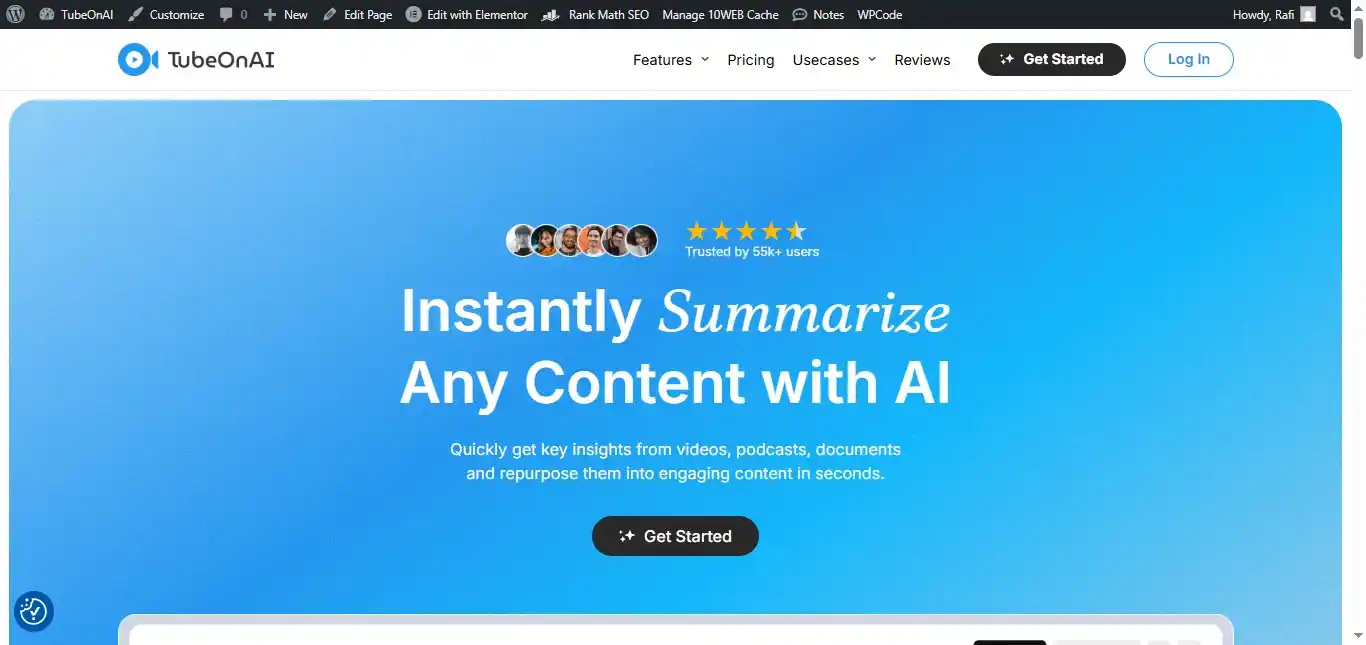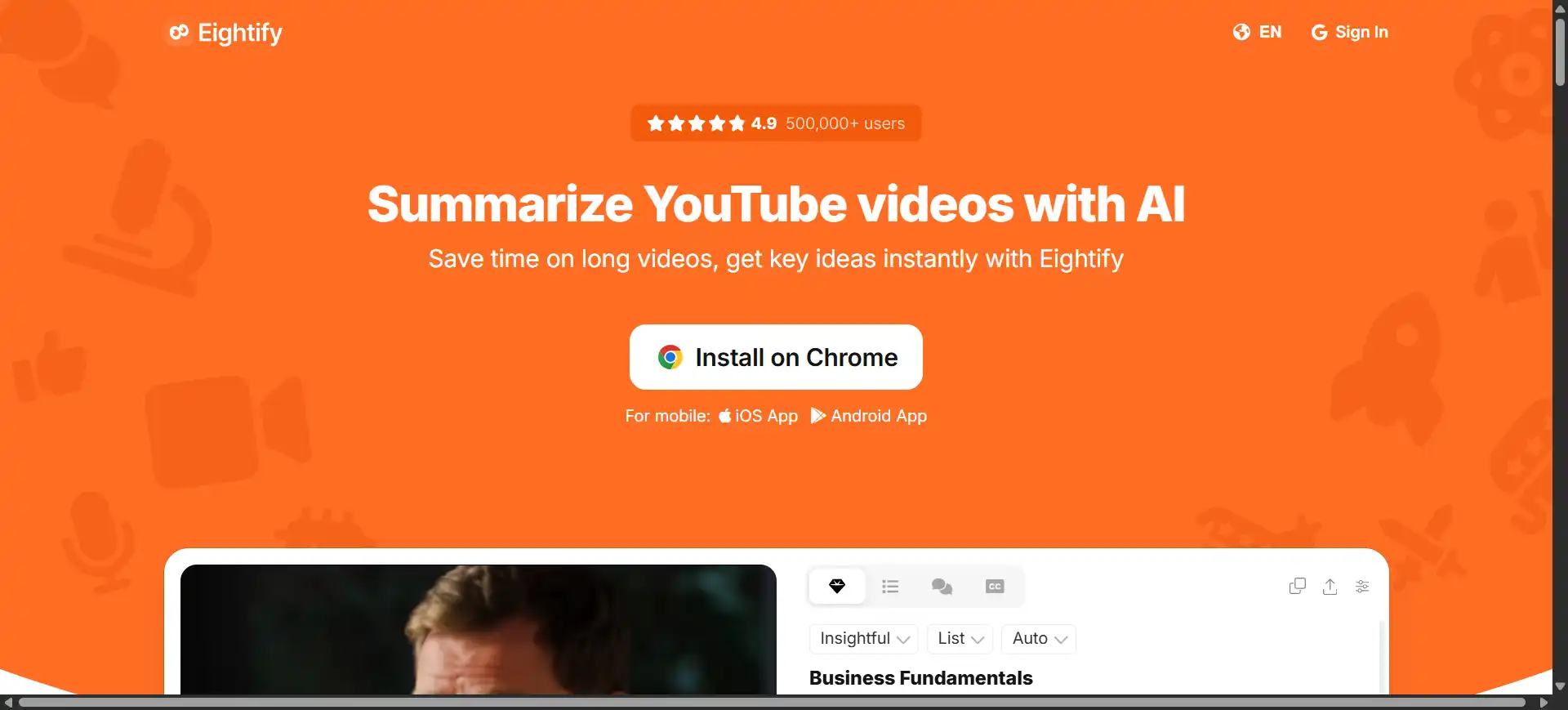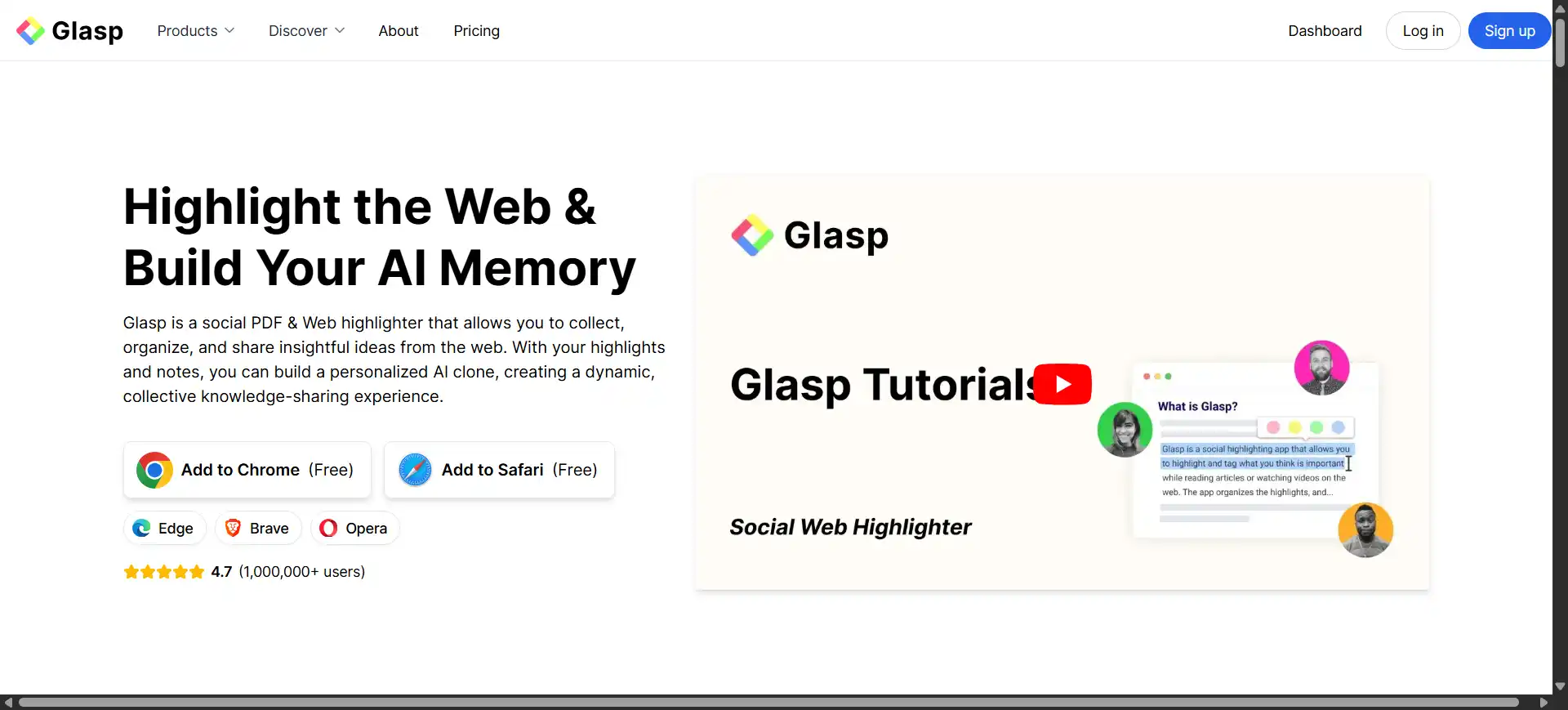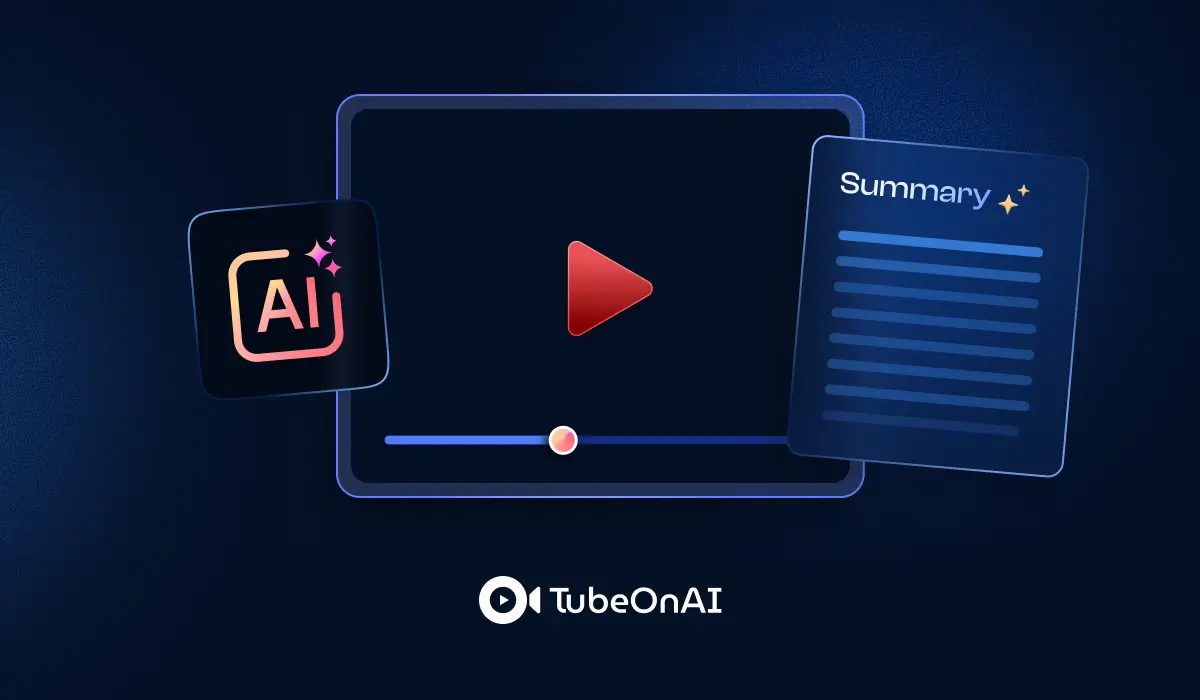AI doesn’t sit and watch a video bit by bit like a human; it follows two things (transcript and audio) to summarize a video.
If a video already contains a transcript, AI directly follows that script to come up with key insights. When there’s no transcript, AI follows the audio, transcribes it, and then starts to summarize.
This process is somewhat lengthy and requires more time than usual.
All of this sounds cool, right? There’s more to it.
In this guide, you’ll learn how this powerful technology works, what benefits it offers, and how you can start using it today to save time and learn much better than before.”

How AI Video Summarization Technology Works
Here is a simple breakdown of how it works-
Step 1: AI Listens to the Video (Speech to Text)
First, the AI focuses on the audio of the video. It uses advanced speech recognition technology to convert all the spoken words into written text. This process is called transcription, and it creates a full script of everything that was said in the video.
Step 2: AI Looks at the Video (Computer Vision)
At the same time, another part of the AI uses computer vision to analyze what’s happening on the screen. It can identify objects, read any text shown in the video (like on slides or in a presentation), and even recognize different scenes or settings.
Step 3: AI Understands the Meaning (Natural Language Processing)
This is the most important step. The AI now takes the written transcript and the information from the visuals and uses Natural Language Processing (NLP) technology to understand the context. It identifies the main topics, key points, important names, and the relationships between different ideas. It’s not just reading words; it’s understanding what they mean together.
Step 4: AI Creates the Summary
Finally, after analyzing all this information, the AI algorithm generates a short, accurate summary. It compiles the most critical information from both the audio and visuals to provide a comprehensive overview of the video’s content. This whole process of automated video summarization saves time while maintaining accuracy.
Types of Content AI Can Effectively Summarize
Today’s powerful AI video summarizer tools can handle a wide variety of file formats and sources like video, audio, podcast or webinars, PDFs, PPTX, and Google Drive files.
Here are the main types of content that AI can effectively summarize:
Various Video Formats: AI summarization tools can summarize any type of video, like YouTube videos, podcasts, or webinars. You can use common video files like MP4, MOV, AVI, and WMV to get the summary of your files.
Audio Files: AI is also excellent at summarizing audio files. If you have a podcast episode saved as an MP3, a recorded interview as a WAV file, or even a simple voice memo, an AI tool can listen to it and provide a detailed written summary.
PDF Documents: You can upload a PDF like a long research paper, a business report, or an e-book, and the AI can generate a short summary of the key points. This saves you from reading the entire document when you just need the main ideas.
Files in Cloud Storage (like Google Drive): Modern AI summarizers can connect directly to cloud storage services like Google Drive. This means you can easily summarize any supported file, whether it’s a video, an audio recording, or a PDF that you have stored in your Drive account, often without needing to download it first. This makes the entire workflow fast, simple, and efficient.
AI vs Human Video Summarization: Accuracy & Speed
Speed: AI is the clear winner here. An AI can summarize a one-hour video in just a few minutes, while it would take a human an hour or more.
Accuracy: AI provides highly accurate summaries for professional, educational, or factual videos. It captures key points and avoids missing important details.
However, humans are better at understanding sarcasm, complex emotions, storytelling, and cultural references. So, while AI is great for information, human summarization can be more accurate for emotional or creative content.
Cost: Using AI video summarization tools is cost-effective in the long run, especially for large files. On the other hand, if you do it manually, it doesn’t cost you anything but takes a long time.
Scale: AI can summarize thousands of videos a day, which is impossible for humans to do.
Best AI Tool to Summarize YouTube Videos
Here are some of the best tools you can use to summarize YouTube videos-
TubeOnAI

When it comes to video summarisation, tubeOnAi is undoubtedly the best tool you’ve ever used. TubeOnAI is not just a tool to summarize YouTube videos; it can summarize podcasts, PDFs, and audio or video files from Google Drive. Not only that, TubeOnAI helps you generate transcripts of the video and audio files and translate them into different languages.
You can turn the sources into blogs, scripts, social media posts, or other formats with its repurpose content feature. It is a very helpful tool for students or any busy professionals who want to save time and use the same content in different ways.

NoteGPT
Notegpt is another useful AI-powered tool that goes beyond summarizing YouTube videos; it can summarize recorded online classes, presentation slides, or meetings. It supports both video and audio content that can turn long recordings into short, clear notes.
Upload video files or paste a link, and NoteGPT will give you a smart summary, transcript, and key points in seconds. It also allows you to save, search, and organize your summaries for easy access later.

Eightify
Eightify is a very simple and fast tool that works only with YouTube videos. It is best for people who want quick information from YouTube. The summary appears beside the YouTube video, and you can copy or save it easily. If you go for the premium version, you can also choose between short or detailed summaries.
Not only a summary, Eightify provides transcripts of the YouTube videos and multilingual support for the users.

Glasp
Glasp is a very popular Chrome extension that works directly in your browser using smart AI like ChatGPT. This tool helps you learn from YouTube videos by providing you with summaries, full transcripts, and allows you to highlight important parts of the video.
Glasp is a great choice for any students, researchers, or busy professionals who want to remember and organize useful information because it gives you the opportunity to write notes, translate the text into other languages and save everything in one place.
Key Benefits of AI Video Summarization
1. Saves Time
AI video summarization helps you get the main points of a long video in just a few seconds or minutes. You don’t need to watch the full video to understand the topic.
2. Improves Productivity
You can focus on the most important parts of the video that helps anyone work faster and learn more in less time.
3. Easy to Understand
AI tools give clear and short summaries using simple language. This makes complex topics easier for everyone, even non-experts.
4. Helpful for Note-Taking
Many AI tools allow you to save highlights, write notes, and organize important points. This is very useful for study, research, or writing.
5. Multi-Language Support
Many tools can translate the summary into different languages. This helps people around the world understand content in their own language.
6. Content Repurposing
Users can turn summaries into blogs, scripts, posts, or reports. It saves effort and time creating new content from videos.
Limitations and Challenges of AI Video Analysis
AI is advancing rapidly, but it still comes with limitations and ongoing challenges.
It can sometimes struggle with:
Poor Audio/Video Quality: If a video is blurry or the sound is unclear, the AI will have a hard time.
Complex Humor and Sarcasm: AI is getting better at understanding nuance, but it can still miss jokes or sarcastic comments.
Heavy Accents or Fast Speech: If someone speaks very quickly or with a very strong accent in a video, the AI transcript might have errors.
Conclusion
AI can watch a video and summarize it even if the video contains no transcript, using its advanced technology.
Tools like TubeOnAI make it easy to handle too much online content, finding the important parts of the video for you and focus on what matters.
This smart technology makes learning more simple, content more accessible, and knowledge more powerful in your hands.
FAQs
1. How accurate are AI video summaries compared to human-made ones?
AI summaries are very accurate, especially for informational videos like lectures or meetings. A human might be better at catching subtle humor or emotion, but for summarizing key facts and data, AI is fast and reliable.
2. What types of videos can AI effectively summarize?
AI is excellent at summarizing structured content like educational videos, business presentations, news reports, how-to tutorials, and documentaries. It works best when the goal is to extract key information and facts.
3. Does AI understand context and nuance in video content?
Modern AI uses Natural Language Processing (NLP) to understand context very well. It can identify main topics and how they relate to each other. However, it can still struggle with very complex human nuances like deep sarcasm or cultural jokes.
4. How does TubeOnAI’s video summarization technology work?
TubeOnAI uses a combination of cutting-edge technologies. It first transcribes the audio to text, then uses computer vision to analyze on-screen elements. Finally, its advanced NLP algorithms analyze all this data to understand the context and generate a highly accurate and comprehensive summary with key insights.


